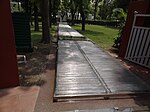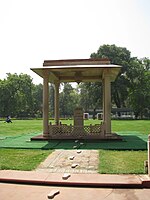Indira Gandhi Memorial
Indira GandhiMuseums in India

The Indira Gandhi Memorial is a museum established to commemorate India's first and the only female Prime Minister Indira Gandhi. It is housed in the building where Gandhi lived with her family during her premiership and where she was assassinated. The museum contains material remains of Gandhi and her son Rajiv Gandhi.
Excerpt from the Wikipedia article Indira Gandhi Memorial (License: CC BY-SA 3.0, Authors, Images).Indira Gandhi Memorial
Safdarjung Road, New Delhi
Geographical coordinates (GPS) Address Phone number Website Nearby Places Show on map
Geographical coordinates (GPS)
| Latitude | Longitude |
|---|---|
| N 28.600277777778 ° | E 77.206111111111 ° |
Address
Indira Gandhi Memorial Museum
Safdarjung Road 1
110011 New Delhi (Chanakya Puri Tehsil)
Delhi, India
Open on Google Maps





